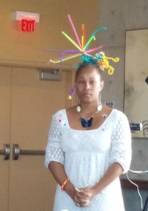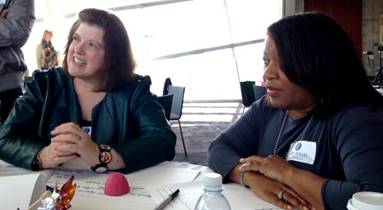Deborah DeLisi presented her One-Minute
Mandalas in the SDVAN sponsored Mission Federal ArtWalk
participation booth on Sat/Sun, April 26/27 from 11am – 6 pm on India at Cedar.
The weather was a challenge but the crowds were huge, friendly and happy. We are very grateful to Deborah and all the
volunteers that helped her. Contact Deborah
for more information on these workshops. Below you can read her report on the
event in her own words, followed by an appreciation from Sandi Cottrell who is
the managing director of the Art Walk organization.
Deborah DeLisi:
I estimate that during
Mission Federal ArtWalk we inspired about 800-900 artists who stopped by the
SDVAN booth to create a unique mandala. We were paid in priceless smiles, and I
know at least one little girl who is going to decorate her bedroom with the
mandalas she made. She is Taylor, the daughter of Angie from Mission Federal,
who was on two local morning TV shows with me last week. Taylor made about 5-6 mandalas and so did her
brother Cody. They were my best 'customers' and a delight.
During ArtWalk, I recognized
some kids who came by BOTH days, and that was nice to see that they enjoyed it
so much they wanted to do it again. What I love about this project is that
EVERYONE SUCCEEDS at it. There are no mistakes, and everyone is amazed at what
they can create, and the simplicity of the process. Seeing the reaction of the
attendees as they unfolded their paper and watched their art develop was
something of which I never tired.
One attendee was a grandpa
who was looking for something to do when he watches his grandkids. He loved
making his mandala, and can't wait to do it with his family. I had at least a
dozen art teachers, school teachers and art enthusiasts who volunteered for
after-school enrichment programs for kids. I spent a bit more time with them,
going over the steps, telling them where to buy the stencils and bling, and why
this is a great activity for kids. One teacher was so excited after making her
mandala that she is going to have her class make them for Mother's Day gifts.
One young girl is going to make the folded-paper mandalas with her friends at
her birthday party. How fun! My booth helpers all said they had so much fun
too.
I want to THANK each of my
volunteers so very, very much for giving up their time, energy, and coming to
Little Italy, to pitch in for non-stop art activities with kids of all ages.
There were fewer breaks than I had hoped for, and any lunch breaks we had were
later than I wanted them and shorter too. But my amazing volunteers rolled with
it, and gave 1000% and I appreciate it so much. I'd like to personally thank: Destiny, Vicki, Olaf, Hector, Steve,
Dani (Danielle), and Carmen. They were AMAZING, ABSOLUTELY
FANTASTIC.
Sandi, thank you for
responding to all my texts and calls when I needed things at the booth. My
calls for help came fast and it was much appreciated and made things flow
smoothly. I'd like Angie at Mission Federal to know that the sponsorship of
ArtWalk created so much joy for others. I hope ALL the artists did well. I
didn't get to walk around but what little I saw was inspiring.
Patricia, thank you for
approaching me last year with the idea to lead this activity at the SDVAN booth
this year. I had a blast. It reminded me how much I enjoy working with kids. I
was 11 years old when I started a business I called "Art School".
I wrote advertisements on pieces of paper and placed them in the mailboxes of
parents on my street that had young kids. I didn't like babysitting, but I
liked doing things with kids (it was more fun.) I charged $1 an hour per child,
and I supplied all the materials. We sat around a picnic table in my
basement and made things with popsicle sticks, paper plates, and other
kid-friendly materials. Until this weekend, I forgot how much fun I had with
"Art School".
Thank you for giving me the
opportunity for such fun and joy during ArtWalk.
You can see the photos
I took at our booth here on Facebook.
PS- there were plenty of
leftover materials for many, many Art Reach projects.
Sandi Cottrell, Managing Director, ArtWalk
San Diego to Deb DeLisi
The weekend got off to such
a rocky start. Having said that…your area was AMAZING! I saw so
many happy people walking away with their artwork, and you had it beautifully
organized. Thank you, thank you, thank you, for making this happen. From the
beginning you were so organized and professional, I can’t imagine a better
project or more lovely person to lead the project. I greatly appreciate
the countless hours you spent on this.
 |
| Deb DeLisi |
 |
| Sand Mandalas |
 |
| Deb DeLisi photo by Rosemary KimBal |











































